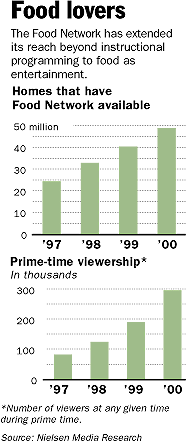 Associated Press Associated Press
NEW YORK — When the Food Network started out in 1993, cooking shows weren’t considered hot TV fare, and chefs weren’t celebrities. Studious cooks watched Julia Child and the Galloping Gourmet truss chickens, but cooking as entertainment had not yet arrived.
Now, bad-boy chef Emeril Lagasse is practically everywhere, along with Mario Batali, Ming Tsai, "Iron Chef" and the various other cultural creations birthed by Food Network, which has gone far beyond its humble beginnings to become a scrappy success story.
Along the way, Food Network also became a meal ticket for its majority owner, the venerable newspaper publisher E.W. Scripps Co. With revenues jumping at about 60 percent a year, Food Network and its sister cable channels are now the company’s main growth engine.
All this would have been hard to predict when Food Network started out. For one thing, America’s growing obsession with cooking and fine dining has certainly helped raise Food Network’s profile — even if it has stumped some of its own executives.
"We’re riding a kind of sociological wave that we don’t really understand," acknowledged network president Judy Girard.
Food Network remains smaller than other niche cable outlets like Discovery and far behind the major networks. But its ability to build its audience beyond the souffle-and-truffles set has advertisers and industry analysts paying close attention.
"When cable was first emerging, this was the kind of thing we laughed at," said Bob Thompson, professor of media and popular culture at Syracuse University. "But the Food Network has been more successful than anyone else at creating a varied lineup centered around a single topic."
While the Food Network may indeed be riding a foodie wave, it’s also doing plenty on its own to grow. As a young company entering a field with no competitors, it has had a free hand to experiment with various formats to see what works and what doesn’t.
Star chefs lead new shows
Last week, the network unveiled its two latest shows, both driven by star chefs.
One follows Wolfgang Puck, a well-connected California restaurateur, as he cooks and mingles with celebrities. The other, "Mario Eats Italy," brings viewers on a kind of gonzo culinary road trip with Batali and a sidekick.
It’s the latest scheduling tweak by programming chief Eileen Opatut, who came on board in 1997 after senior posts at the BBC’s U.S. operation and at National Geographic, where she pioneered the "Explorer" show.
"None of us have the hubris to think that we know the answers," said Opatut, who has launched 30 series and 125 specials during her tenure at Food Network. Like a good chef, she said, "we’re always experimenting."
In some cases, they strike gold. Who could have guessed that a campy Japanese cooking contest show called "Iron Chef" would amass a cult following, or that two hefty British ladies who tool around on an old motorcycle would wow viewers with lardsome recipes and posh accents?
"You keep pushing the envelope outward until you find something that doesn’t work," says Ed Spray, president of Scripps Networks.
This freewheeling approach has netted any number of oddball formats, including one in which a host knocks on a family’s door and has a chef come in to cook a gourmet dinner with whatever is lying around in the refrigerator. By the same token, the network also has no problem pulling shows that bomb, such as the first two efforts to get Lagasse on the air.
Lagasse’s brash style and curious love of pork fat may have alienated some viewers, but his following remains loyal. At a recent New York taping of "Emeril Live," one of the network’s top shows, Ed Cichone drank in the wild atmosphere as the chef whipped up Cuban specialties like mojitos and tostones.
A computer consultant by day, Cichone says he uses the Food Network Web site for nearly all his recipes, and once even staged a mock cooking contest at home a la "Iron Chef."
As Scripps continues to tinker with Food Network and HGTV, a home and gardening channel, it’s also hoping to whip up other successful single-topic channels. Its home improvement channel DIY (Do It Yourself) started up about a year ago, and a lifestyle channel Fine Living is due to launch in the second half of this year.
But analysts say the kind of growth Food Network is seeing over the past two years may be hard to duplicate. Since 1998 the number of homes where Food Network can be see has nearly doubled to 54 million, and prime time viewership has more than doubled to 295,000, according to Nielsen Media Research.
Their timing couldn’t be better. Investors now place a huge premium on specialty cable channels, as seen by the rich $2.3 billion that Viacom Inc. agreed to pay last fall for BET, a major minority broadcaster.
Profits despite changes
The Food Network turned a tiny profit in 1999, a full year ahead of schedule, on revenue of $66.6 million.
But there’s been some rough going along the way. It’s on its fourth president since founder Reese Schonfeld left in late 1995, and ownership changed hands several times until Scripps took a controlling interest in 1997.
With ownership and management turmoil abated now, Food Network is concentrating on cooking up more hits and expanding its name recognition. A street-level studio is planned to open next year in Manhattan’s swank Chelsea Market, and a cooking school and kitchen products are also in the works.
Opatut, the programming chief, says shows about cooking and eating are more than a passing fad.
"Food is a vocabulary that people are starting to share," Opatut said. "We’re tapping a need in our culture for something that centers them. There’s a greater need for people to connect to each other, and that link is often food."
[back to top] |

 Associated Press
Associated Press